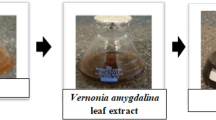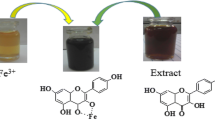Abstract
The synthesis of metal oxide nanoparticles has gained much attention due to its wide range of applications in the field of industrial, chemical, and biological applications. These metallic nanoparticles have been developed for azo-dye removal, but they are limited for ecofriendly and cost-effective processes. The main objective of this study is to focus on the synthesis of Fe2O3-nanoparticles by green route followed by its application in the dye removal process from wastewater. In this approach, the active iron oxide nanoparticles (Fe2O3-NPs) were produced successfully using Camellia sinensis and Aloe barbadensis leaf extract. The prepared nanoparticles were characterized using SEM, XRD, FTIR, and UV–Vis spectroscopy, As per results, the NPs effectively degraded both the azo-dyes from the aqueous solution with 70–80% removal efficiency in 40–45 min under optimum conditions. Moreover, the color change in the solution indicated the formation of Fe2O3-NPs. The absorption peak was observed at 275 nm and 270 nm for Aloe barbadensis leaf extract and Camellia sinensis extract, respectively. The FTIR peak at 553.63 cm−1 indicates the presence of Fe2O3 NPs along with other peaks at 2853.3 cm−1 for O–H stretching in carboxylic acid; at 3404 cm−1 due to the O–H group present in the extract, broad peak of 3406 cm−1 shows –OH group of carbohydrates and phenols along with a peak at 2891 cm−1 for asymmetrical and symmetrical C-H stretching. The results of XRD and SEM indicate the homogeneity, shape, and size of NPs, which were spherical and cubic. The size of the particles ranged between 80 and 100 nm for both types of NPs prepared using the extracts. The Langmuir and Elovich isotherms were used to analyze adsorption behavior. The pseudo-first-order and pseudo-second-order kinetic approaches were used and found satisfactory for both approaches. An extensive discussion has been made in light of the experimental data and results obtained.










Similar content being viewed by others
Data availability
The data presented in this work is available with the corresponding author and can be provided on considerable request.
References
Wu F, Misra M, Mohanty AK (2021) Challenges and new opportunities on barrier performance of biodegradable polymers for sustainable packaging. Prog Polym Sci 117:101395. https://doi.org/10.1016/J.PROGPOLYMSCI.2021.101395
Salem SS, Badawy MSEM, Al-Askar AA et al (2022) Green biosynthesis of selenium nanoparticles using orange peel waste: characterization, antibacterial and antibiofilm activities against multidrug-resistant bacteria. Life 12:893. https://doi.org/10.3390/LIFE12060893
Pereira ADES, Oliveira HC, Fraceto LF, Santaella C (2021) Nanotechnology potential in seed priming for sustainable agriculture. Nanomaterials 11:1–29
Polshettiwar V, Varma RS (2010) Green chemistry by nano-catalysis. Green Chem 12:743. https://doi.org/10.1039/b921171c
Salem SS, Fouda A (2020) Green synthesis of metallic nanoparticles and their prospective biotechnological applications: an overview. Biol Trace Element Res 1(199):344–370. https://doi.org/10.1007/S12011-020-02138-3
Salem SS (2022) Bio-fabrication of selenium nanoparticles using baker’s yeast extract and its antimicrobial efficacy on food borne pathogens. Appl Biochem Biotechnol 194(5):1898–1910. https://doi.org/10.1007/S12010-022-03809-8
Hunt AJ, Anderson CWN, Bruce N et al (2014) Phytoextraction as a tool for green chemistry. Green Processing and Synthesis 3:3–22. https://doi.org/10.1515/GPS-2013-0103
Salem SS, Hammad EN, Mohamed AA, El-Dougdoug W (2023) A comprehensive review of nanomaterials: types, synthesis, characterization, and applications. Review 13:41. https://doi.org/10.33263/BRIAC131.041
Al-Rajhi AMH, Salem SS, Alharbi AA, Abdelghany TM (2022) Ecofriendly synthesis of silver nanoparticles using Kei-apple (Dovyalis caffra) fruit and their efficacy against cancer cells and clinical pathogenic microorganisms. Arab J Chem 15:103927. https://doi.org/10.1016/J.ARABJC.2022.103927
Ndolomingo MJ, Bingwa N, Meijboom R (2020) Review of supported metal nanoparticles: synthesis methodologies, advantages and application as catalysts. J Mater Sci 55:6195–6241. https://doi.org/10.1007/s10853-020-04415-x
Abdelmoneim HEM, Wassel MA, Elfeky AS et al (2021) Multiple applications of CdS/TiO2 nanocomposites synthesized via microwave-assisted sol–gel. J Clust Sci 33(3):1119–1128. https://doi.org/10.1007/S10876-021-02041-4
Shehabeldine AM, Salem SS, Ali OM et al (2022) Multifunctional silver nanoparticles based on chitosan: antibacterial, antibiofilm, antifungal, antioxidant, and wound-healing activities. J Fungi 8:612. https://doi.org/10.3390/JOF8060612
Salem SS (2022) Baker’s yeast-mediated silver nanoparticles: characterisation and antimicrobial biogenic tool for suppressing pathogenic microbes. BioNanoScience 2022:1–10. https://doi.org/10.1007/S12668-022-01026-5
Morales G, Campillo G, Vélez E et al (2019) Green synthesis of magnetic nanoparticles using leaf extracts of Aloe vera and Kalanchoe daigremontiana to remove divalent mercury from natural waters. J Phys Conf Ser 1247:012021. https://doi.org/10.1088/1742-6596/1247/1/012021
Day CM, Sweetman MJ, Hickey SM et al (2021) Concept design, development and preliminary physical and chemical characterization of tamoxifen-guided-mesoporous silica nanoparticles. Molecules 26:1. https://doi.org/10.3390/MOLECULES26010219
Aidaros N, Mosallam R, Farouk H (2021) Effect of green tea, black tea and moringa oleifera on remineralization of artificially demineralized enamel and dentin: an in-vitro microhardness analysis. Adv Dental J 3:24–34
Akhter F, Soomro SA, Siddique M, Ahmed M (2021) Plant and non-plant based polymeric coagulants for wastewater treatment: a review. J Kejuruteraan 33:175–181. https://doi.org/10.17576/jkukm-2021-33(2)-02
Akhter F, Rao AA, Abbasi MN et al (2022) A comprehensive review of synthesis, applications and future prospects for silica nanoparticles (SNPs). Silicon. https://doi.org/10.1007/s12633-021-01611-5
Gunalan S, Sivaraj R, Venckatesh R (2012) Aloe barbadensis Miller mediated green synthesis of mono-disperse copper oxide nanoparticles: optical properties. Spectrochim Acta A Mol Biomol Spectrosc 97:1140–1144. https://doi.org/10.1016/j.saa.2012.07.096
Paulpandian P, Beevi IS, Somanath B et al (2022) Impact of Camellia sinensis iron oxide nanoparticle on growth, hemato-biochemical and antioxidant capacity of blue gourami (Trichogaster trichopterus) fingerlings. Biol Trace Elem Res. https://doi.org/10.1007/S12011-022-03145-2
Picollo M, Aceto M, Vitorino T (2019) UV-Vis spectroscopy. Physical Sciences Reviews 4:4. https://doi.org/10.1515/PSR-2018-0008/MACHINEREADABLECITATION/RIS
Acknowledgements
Thanks to GCU CASP department for providing SEM, XRD, FT-IR facility.
Author information
Authors and Affiliations
Contributions
Zubia Anwar, Abdul Rauf Jamali, Waseem Khan: Abstract, introduction, materials and methods. Jahanzeb Bhatti, Faheem Akhter, Madhia Batool, Zubia Anwar: Results and discussion, conclusion. Zubia Anwar: Thorough revision of manuscript by implementing the reviewers’ comments.
Corresponding author
Ethics declarations
Ethics approval and consent to participate
Not applicable.
Competing interests
The authors declare no competing interests.
Additional information
Publisher's note
Springer Nature remains neutral with regard to jurisdictional claims in published maps and institutional affiliations.
Rights and permissions
Springer Nature or its licensor (e.g. a society or other partner) holds exclusive rights to this article under a publishing agreement with the author(s) or other rightsholder(s); author self-archiving of the accepted manuscript version of this article is solely governed by the terms of such publishing agreement and applicable law.
About this article
Cite this article
Anwer, Z., Jamali, A.R., Khan, W. et al. Green synthesis of active Fe2O3 nanoparticles using Aloe barbadensis and Camellia sinensis for efficient degradation of malachite green and Congo red dye. Biomass Conv. Bioref. (2022). https://doi.org/10.1007/s13399-022-03626-3
Received:
Revised:
Accepted:
Published:
DOI: https://doi.org/10.1007/s13399-022-03626-3




